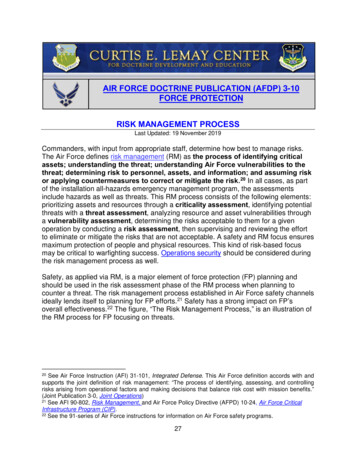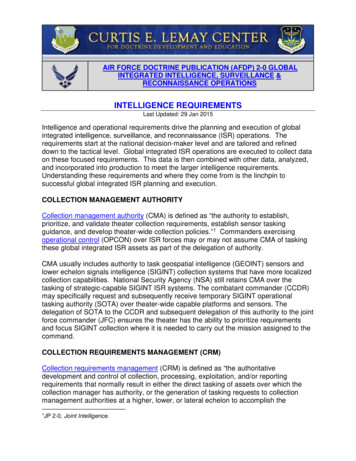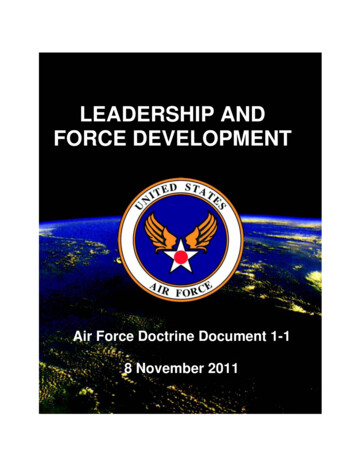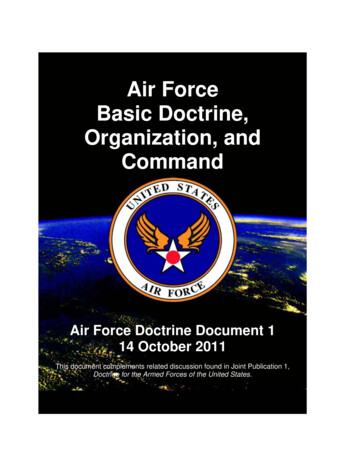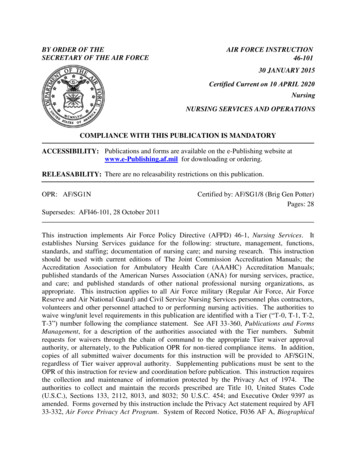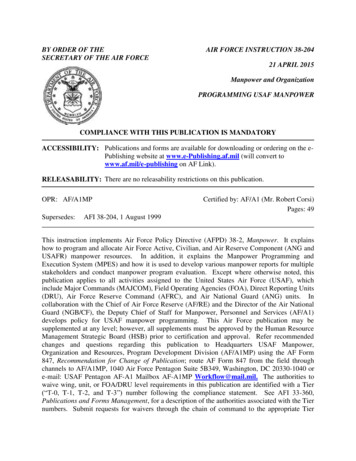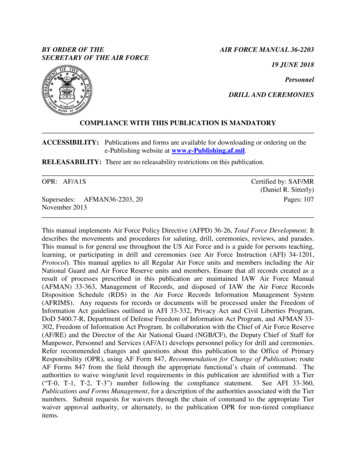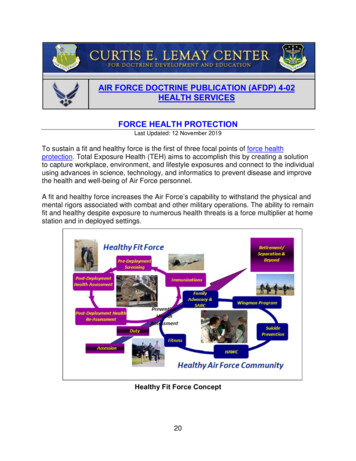
Transcription
AIR FORCE DOCTRINE PUBLICATION (AFDP) 4-02HEALTH SERVICESFORCE HEALTH PROTECTIONLast Updated: 12 November 2019To sustain a fit and healthy force is the first of three focal points of force healthprotection. Total Exposure Health (TEH) aims to accomplish this by creating a solutionto capture workplace, environment, and lifestyle exposures and connect to the individualusing advances in science, technology, and informatics to prevent disease and improvethe health and well-being of Air Force personnel.A fit and healthy force increases the Air Force’s capability to withstand the physical andmental rigors associated with combat and other military operations. The ability to remainfit and healthy despite exposure to numerous health threats is a force multiplier at homestation and in deployed settings.Healthy Fit Force Concept20
Concept for Fit and Healthy ForceFit and healthy Airmen can deploy on short notice and operate effectively in austereenvironments. Using TEH for early identification and intervention of health conditionsthat could otherwise prohibit Airmen from being fully ready to deploy, increases thecommander, Air Force forces’ (COMAFFOR’s) ability to mass forces. Fitness includes atleast fitness for military service, for Air Force specialty code, for deployment, andspecial operational duties and implies abiding fitness for in garrison duties, periodicfitness for deployed duty, and on-demand fitness for emergency or disaster-responseduties anyway.Prevent Illness and InjuryTo prevent illness and injury is the second of three focal points of force healthprotection. Illness and injury prevention is the framework by which Air Force leaders andindividuals optimize health readiness and protect Airmen. The force health protectiongoal is to prevent illness and injury from the physical and mental stress caused byenvironmental, occupational, operational, and warfare; to include chemical, biological,radiological, and nuclear (CBRN) threats. Air Force medical personnel recognize andprepare for emerging man-made and natural threats. They make reasonable efforts toidentify and protect our forces from emerging infectious diseases, as well as potentialgenomic/proteomic, directed energy, non-traditional agents, and other newtechnologies. Casualty prevention is a continuous process conducted throughout predeployment, deployment, and post-deployment phases. Illness and injury preventionrequires the full commitment of commanders, leaders, and individuals.Medical forces arrive early as an integral part of the beddown team to assess threats;mitigate hazards to acceptable levels for operations; and to protect Airmen. Medicalforces conduct routine standardized exposure monitoring and tracking of disease andinjury rates to assist commanders in taking data-driven corrective actions at all levels.Automation and data collection are conducted at the lowest echelon, and actionabledata are transferred to each echelon of command. This enables a full health riskassessment for the operational missions and the development of risk-mitigatingrecommendations for commanders.During deployment and follow-on operations, adversaries and the total environmentgenerate threats to forces. Enemies produce combat-related casualties, commonlycalled battle injuries; while the environmental, safety, and occupational health threats, ortotal-environment threat, produce disease and non-battle injury (DNBI) casualties. 7DNBIs historically have accounted for three-quarters or more of battlefield casualties,although this proportion has decreased dramatically since the advent of modern medicalpractices. Casualty prevention historically has focused on reducing or eliminating therisk of food-, water-, waste-, and insect-borne illnesses, as well as heat and cold injuriesduring deployments. However, in today’s environment, increased risk from covert7Department of Defense Instruction 6490.03, Deployment Health.21
chemical and biological contamination by terrorists has expanded casualty prevention toinclude the monitoring of food, air and water for chemical and biological agents. Recentoperations demonstrated the need to emphasize environmental and occupationalexposures and combat stress in addition to DNBI.Medical capabilities include refined military medical surveillance and objective exposuremeasurements to identify threats, assess risk, and develop countermeasures to meetactual and potential threats. Considerations to prevent casualties include: Total Exposure Health: Includes workplace, environmental, and lifestyle exposuresto the individual. TEH integrates exposure science and information technology toanalyze and translate all data into clinically and personally actionable results. Non-Adversary Threats: These are naturally occurring in the environment or aresult of past or present military operations and may include endemic diseases,motor vehicle accidents, sports or recreational injuries, body stresses due to wearingof personal protective equipment and other equipment, heat and cold exposure,biological exposures, and chemical and radiation exposures from industrial sources. Adversary Threats: The result of deliberate attack, which can include CBRNagents. As a mitigating tool, health surveillance may likely be the first indicator of abiological, chemical, or other attack. Identifying Preventable Threats and Implementing Countermeasures: Casualtyprevention requires medical forces to identify preventable threats and forcommanders, leaders, and individuals to implement countermeasures. Medicalforces provide location and task-specific threat knowledge and casualty preventionlessons learned. Commanders mitigate casualties before operations begin bydirecting required immunizations or chemoprophylaxis, engineering solutions,managerial controls, or personal protective equipment that mitigates identifiedthreats. Additionally, aerospace medicine functions directly support operations toensure health and safety of the total force by conducting health risk assessmentsand pre- / post-mishap investigation of human factors that are causal or contributoryin over 70 percent of mishaps. Medical experts coordinate with safety personnel toinvestigate and analyze unit safety culture and mishap human factors, with the goalof providing actionable safety information to operational commanders, acquisitionsefforts and individual Airmen. During operations, medical forces use automatedinformation support systems and equipment designed for detection, monitoring, andevaluation of occupational, environmental, and CBRN threats to assess risk andrecommend mitigating actions to commanders. Disease Prevention: Medical forces use current medical information data to identifyinfectious disease threats to Airmen at home station and deployed locations. 8 TheAir Force tracks the vaccination status of all Airmen to ensure protection against8Air Force Instruction (AFI) 48-105, Surveillance, Prevention, and Control of Disease and Conditions ofPublic Health or Military Significance.22
vaccine-preventable diseases such as typhoid, meningitis, and influenza. At eachairfield, medical forces assess disease threats and implement appropriatecountermeasures, particularly in the areas of food and water vulnerability, wastedisposal, and control of disease-carrying vectors. Dental Disease Prevention: The Air Force Dental Service collects extensive riskassessment and dental readiness information to provide commanders an accuratepicture of the dental fitness of their personnel. 9 Severe dental pain rarely can bemanaged by self-care and most often requires professional intervention withspecialized equipment. Mental Health Casualty Prevention: The mental health of Airmen is critical tomission success. In the Air Force, the concepts of prevention and resilience are thetwo keys to mental health casualty prevention. In the deployed environment, medicalforces identify mental health problems and provide appropriate care. Mental healthpersonnel prepare the fighting force for mission readiness throughout thedeployment cycle. Air Force members should be vigilant for signs of mental distressand act decisively to obtain assistance for themselves and others. Medical Intelligence: Medical forces require seamless medical surveillance andintelligence integration with Air Force, Department of Defense, interagency andinternational agencies to maintain vigilance against emerging diseases and enemythreats. Global Vigilance: Global vigilance is the ability to gain and maintain awarenessanywhere in the world; provide warning; and determine intent, opportunity,capability, or vulnerability. Medical surveillance and information provide crucialsupport to medical operations and provide essential information to the joint forcecommander. Included within this capability are medical information systems andprocesses to detect and warn of possible disease outbreaks.Provide Casualty Care and ManagementTo restore health is the third of three focal points of force health protection. Medicalforces use combined processes to rapidly restore each Airman to a combat ready statusor arrange for the appropriate rehabilitative services. Restoring health requires acontinuum of medical capabilities that includes first responders, forward resuscitativecare (FRC), en route care, theater hospitalization, and definitive care. First Responder: The first responder is the initial stabilizing medical care renderedto casualties at the point of injury or illness. Collectively, this includes self-aid /buddy care and immediate care and stabilization of individuals by medical personnelto return to duty or coordinate aeromedical evacuation.9AFMAN 47-101, Managing Air Force Dental Services.23
Emergency Responder: Emergency responders are called upon if a specificincident dictates a particular need or hazard requires an immediate assessment. AirForce medical emergency responders, as defined by the Air Force IncidentManagement System, are members of the disaster response force elements thatdeploy after the first responders to expand command and control and provideadditional support. Emergency responders include follow-on medical treatment andpreventive medicine teams, with training in field sanitation; behavioral;environmental; occupational; operational; industrial; or CBRN warfare healthassessment and management. Forward Resuscitative Care: The FRC is forward advanced emergency medicaltreatment performed as close to point of injury as possible. FRC makes extensiveuse of technology and advanced emergency medical treatment and surgical practiceto increase initial surgical efficiency. Requirements for medical logistic support(blood and medical materiel) including varying re-supply, storage, and distributioncapabilities, are intrinsically linked. The goal is stabilization. Properly designed,equipped, and employed, FRC capabilities can provide a decreased forward medicalfootprint while enhancing the capability to sustain life and limb and should beavailable as close to the point of injury as operational conditions permit. En Route Care: En route care is the continuation of care during movement(evacuation) within the health service support continuum of care without clinicallycompromising the patient’s condition. En route care involves transitory medical care,en route critical care, patient holding, and staging capabilities during transport fromthe site of injury or onset of disease, through successive capabilities of medical care,to a medical treatment facility that can meet the needs of the patient. En route careconsists of three phases: Casualty Evacuation (CASEVAC) involves the unregulated movement ofcasualties aboard ships, land vehicles, or aircraft. Medical Evacuation (MEDEVAC) refers to dedicated medical evacuationplatforms staffed and equipped to provide en route medical care using predesignated tactical or logistic aircraft, boats, ships, and other watercrafttemporarily equipped and staffed with medical attendants for en route care. Aeromedical Evacuation (AE) specifically refers to “the movement of patientsunder medical supervision to and between medical treatment facilities by airtransportation” (JP 4-02, Joint Health Services). AE provides time-sensitive inflight care of patients or casualties to and between levels of care usingpredominantly mobility air forces aircraft or contracted aircraft (civilian airambulance) with medical aircrew trained specifically for this mission. Theater Hospitalization: Theater hospitals are designed to provide in-theatersupport. This includes all care and capabilities required to support the theater suchas emergency, surgical, public health, dental, preventive, stress control, and24
ancillary services. Air Force theater hospitalization capabilities deploy as modules ormultiple individual capabilities. Definitive Care: Definitive care is rendered to personnel to conclusively manage thecondition, injury, or illness. This normally leads to rehabilitation, return to duty, ordischarge from the Service. Definitive care capability includes the full range of acute,convalescent, restorative, and rehabilitative care provided at definitive andrehabilitative care sites outside the operational area.Air Force medical forces are designed, organized, and employed to stabilize sick andinjured persons and expedite transport to definitive care while maintaining or increasingthe standard of care en route. The nature of airpower provides Air Force medical forceswith worldwide responsive operational reach between airfields in a theater of operationsas well as the strategic reach to any global definitive care capability.Roles of Medical CareUS doctrine uses roles of care to describe battlefield medical and health capabilities.Some of the North Atlantic Treaty Organization (NATO) definitions for roles of care aredifferent from US doctrinal definitions. NATO roles consist of first / emergencyresponder (Role 1), forward resuscitative care (Role 2), theater hospitalization (Role 3),and definitive care (Role 4). See Joint Publication 4-02, Joint Health Services, ChapterII, Health Service Support, for specific details on each of these roles of medical care.Optimize Human PerformancePersonnel are the most important and valuable resource for the Air Force. Accordingly,Air Force Medical Service (AFMS) focuses on human performance in addition to healthcare as a primary means of supporting the COMAFFOR. Given the prerequisite needfor health, addressing human performance requires achievement of the AFMS effects of“a healthy and fit force” and “prevent illness and injury”—two key focal points of forcehealth protection.The AFMS becomes a force multiplier by focusing on human performance in addition toTEH as the primary means of supporting Air Force and joint forces. Air Force medicalpersonnel work to sustain the performance of Airmen, whether in the face of enemyconflict, environmental threats and stressors, or advancing age. Any activity thatsupports or encourages improvement in physical, mental, or emotional health andfitness contributes to sustaining human performance. Additionally, Air Force medicalpersonnel develop risk mitigation approaches. They employ approved countermeasuresto help Airmen maintain performance (or minimize performance degradations) duringwarfare or upon exposure to environmental threats such as climatic extremes,gravitational forces, fatigue, weapons effects, prolonged mental or physical stress,witnessing or participating in violent acts.25
Management of FatigueMedical forces readily provide fatigue management training resources to aircrew andextend fatigue management capabilities to battlefield Airmen, security forces, criticalcare air transport teams, and other personnel that operate around the clock. Fatiguemanagement, in all of its forms, is used by commanders as a means of sustaining andoptimizing warfighter effectiveness.Cognitive PerformanceOptimizing and sustaining cognitive performance provides an advantage in the analysis,synthesis, and collation of information and timely action or reaction. Maintaining thehighest degree of cognitive capacity improves information management quality and mayattenuate fear, stress, or confusion.Improved Physical Performance to Operate in All EnvironmentsAir Force medicine optimizes and sustains the Air Force’s ability to operate across thefull range of military operations. The goal is to reduce the physical demands on thewarfighter and sustain the ability to complete the mission. Airman performance mayneed to be sustained regardless of adverse conditions due to unfavorable weather,temperature, or lightning; high altitude; rough terrain; gravitational effects; directedenergy; or CBRN effects. The Air Force maintains an extensive array of methods andequipment to optimize and sustain warfighter performance under these conditions.These methods may range from sunscreen to spacesuits, medications to body armor,glasses to night vision goggles, and vaccines to rapid diagnostics. Cutting-edge effortsto enhance physical performance include manipulation of metabolic processes andaddition of equipment or mechanical augmentation.Weapons Effects on Human Performance and HealthAir Force medicine has a role in assessing weapons effects on human performance andhealth in an effort to advise commanders, support development of effectivecountermeasures against threats, and develop injury treatment. Assessing the effects ofweapons against individuals or groups can supply information for the risk managementprocess or developing defensive measures. Many performance and health impacts fromtraditional warfare methods such as kinetic and CBRN weapons are well known, andperformance and health impacts of less traditional warfare methods such as directedenergy systems, laser, less than lethal agents, psychological warfare, and thermobaric(heat pressure) weapons are being further assessed and investigated.26
total-environment threat, produce disease and non-battle injury (DNBI) casualties. 7 DNBIs historically have accounted for three-quarters or more of battlefield casualties, although this proportion has decreased dramatically since the advent of modern medical practices. Casualty prevention historically has focused on reducing or eliminating the

